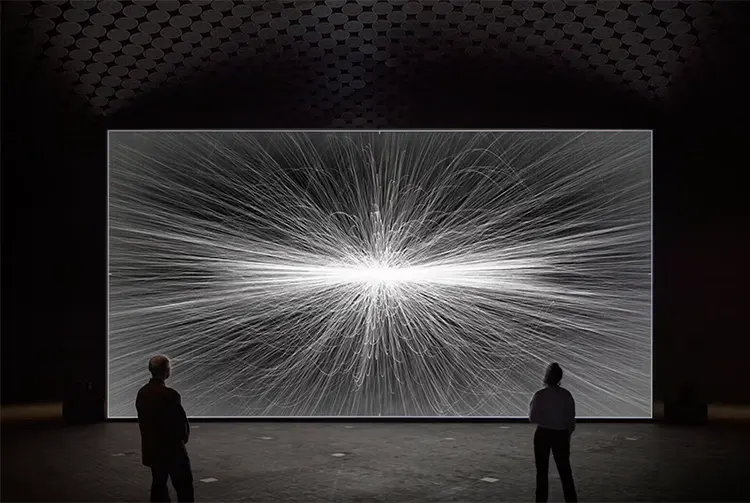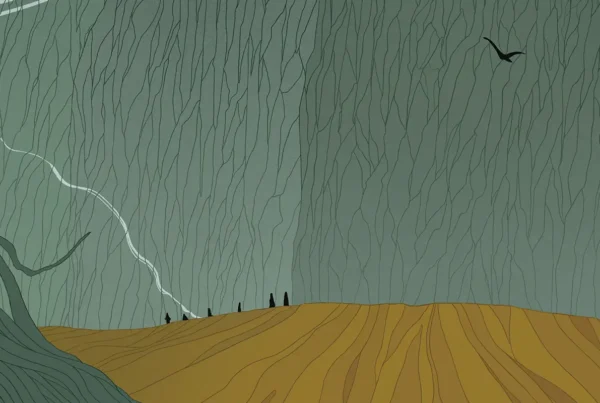From Gifu to Global: The Evolution of a Sound Visionary
Ryoji Ikeda‘s journey from his birth in 1966 in Gifu Prefecture, Japan, to becoming a seminal figure in the world of visual and sound art in Paris, France, encapsulates a profound exploration of sound’s raw elements. Ikeda’s fascination with the fundamentals of sound—sine tones, noise, and their interaction with human auditory systems—ignited a lifelong quest to push these components beyond conventional boundaries. This exploration is deeply rooted in his early curiosity about sound’s elemental forms and how they could be manipulated to forge new, imaginative auditory experiences. Ikeda’s relocation to Paris marked a significant phase in his career, offering him a broader canvas to delve deeper into the sonic exploration that defines his unique artistic signature.
The artist’s approach to creating music is akin to a meticulous scientific inquiry, where complex soundscapes emerge from the interplay of intricate beat patterns, tones, and noise. These compositions, often resembling the output of drum machines, span across genres from ambient to lowercase, creating evolving auditory landscapes devoid of traditional rhythmic pulses. This process of continuous experimentation reflects Ikeda’s dedication to challenging the limits of music and sound. His innovative use of sound design not only captivates the auditory senses but also ventures into the realm of visual art, creating a holistic sensory experience that transcends the conventional separation of the senses.
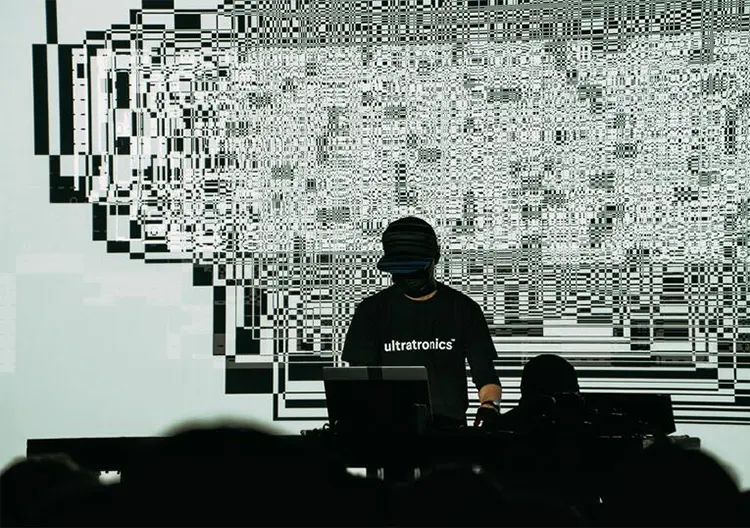
Ryoji Ikeda: Collaborative Explorations and Immersive Experiences
Ryoji Ikeda’s collaborations have been pivotal in expanding his artistic horizons. Working with individuals like Carsten Nicolai and collectives such as Dumb Type has not only broadened his perspective but also introduced him to novel techniques and conceptual frameworks. The collaboration on the project “Cyclo.” with Nicolai stands out as a cornerstone in Ikeda’s career, pushing him to explore the visualization of sound. These partnerships have been instrumental in shaping his approach to art, encouraging a fusion of ideas and disciplines that continue to influence his work profoundly.
Ikeda’s immersive audio-visual projects, particularly “The Transfinite,” represent his ambition to redefine the audience’s engagement with art. By creating environments that envelop viewers in a sensory experience, Ikeda invites deep, personal interactions with his installations. These projects aim to transcend ordinary perception, offering viewers a space to experience art in a manner that is both profound and intensely personal. This drive to present new ways of experiencing sound and visuals underscores Ikeda’s role as an innovator, constantly seeking to push the boundaries of what art can be and how it can be experienced.
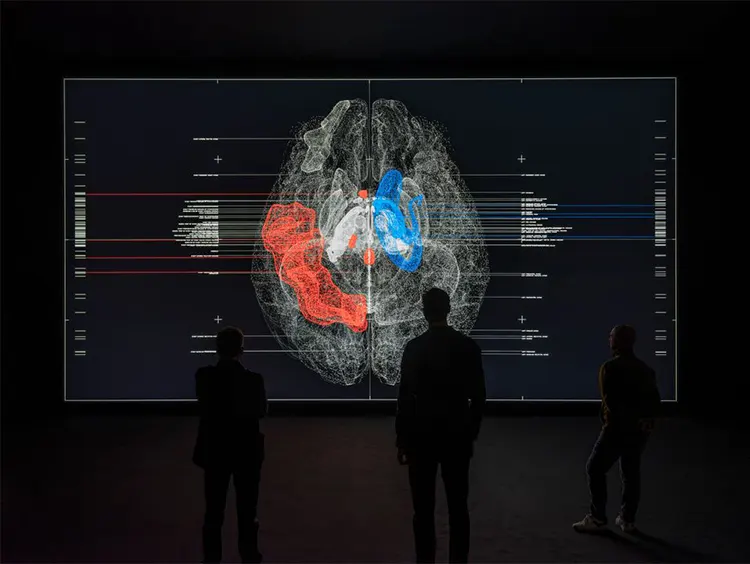
Data as Medium: The “Test Pattern” Revolution
Ryoji Ikeda’s “Test Pattern” series stands as a testament to his pioneering work in transforming data into captivating art. This innovative project reimagines how text, sound, and visual data can be experienced, transcending traditional artistic mediums. By converting real-time data into binary visual and auditory experiences, Ikeda challenges our perception of data’s role in art. The meticulous process involves a computer program that translates various data forms into a binary code, creating a hypnotic, strobe-laden visual spectacle accompanied by complex sound compositions. This approach not only pushes the viewer to the brink of sensory overload but also invites a deeper contemplation of the world through a data-driven lens, showcasing Ikeda’s ability to blend technological prowess with artistic vision.
The conceptual foundation of “Test Pattern” reflects Ikeda’s broader interest in the intersections between data, sound, and visual art. By making data perceivable in novel ways, he bridges the gap between abstract information and sensory experience. This project exemplifies his commitment to exploring the potential of digital technologies in art, pushing the boundaries of how data can be interpreted and appreciated. Ikeda’s work in this domain is not just about the aesthetics of data visualization; it’s a profound inquiry into the essence of perception and the infinite possibilities that lie at the intersection of technology, art, and data.
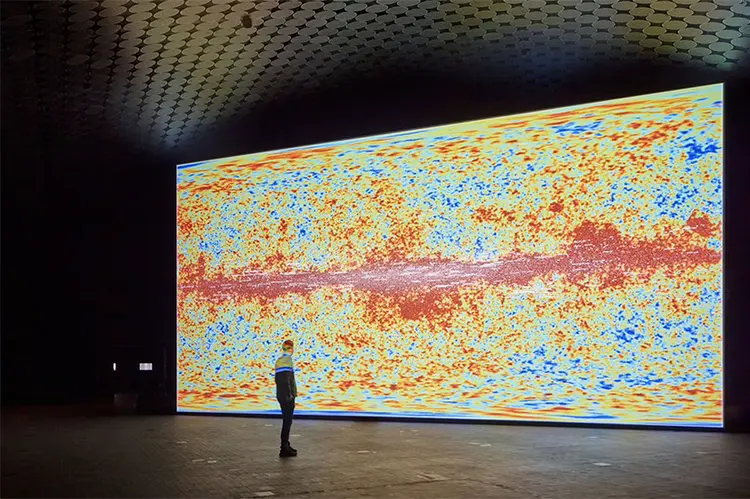
Ryoji Ikeda: Datamatics and Beyond
In his “Datamatics” project, Ryoji Ikeda ventures into the conceptual realms of the infinite and the unknown, using data as a medium to explore the vastness of the universe. This exploration is deeply rooted in Ikeda’s fascination with how data can bridge the microscopic and macroscopic worlds, offering a unique perspective on the cosmos. By utilizing sources such as hard drive errors and software code, Ikeda crafts an experience that simulates the sensation of traversing the universe, accompanied by a cosmic soundtrack. This project is emblematic of his ability to conceptualize the relationship between data, sound, and the universe, pushing the audience to contemplate the limits of human perception and the enormity of the cosmos.
Balancing the contrasts between light and dark, silence and sound, is central to Ikeda’s installations, creating a dialogue that enhances the sensory impact of his work. This careful modulation of elements is crucial in fostering immersive experiences, inviting viewers to explore the boundaries of their own perception. Ikeda’s installations are not merely artistic expressions but are designed as spaces for interaction, where the interplay of light, sound, and data creates a dynamic environment for exploration. As Ikeda continues to innovate, his future projects promise to delve deeper into the relationship between art and data, exploring new avenues for creative expression. His relentless curiosity and commitment to pushing the limits of technology and art hint at endless possibilities, ensuring that his journey remains as infinite as the themes he explores.
